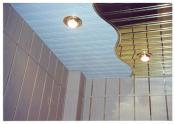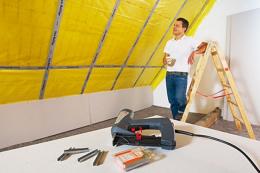Search
Login
Recommended
How to make a competent sound insulation of the roof in the house, do the right sound insulation of the roof
About 80% of all roofing materials that are used today in construction are corrugated and metal. The reason for this popularity is a long period of operation, attractive appearance, reliability and resistance to weather disasters. The ease of installation and the low cost of materials, the variety of commercially available reliefs and colors are also attractive.
Content
- For what reasons may additional insulation of the roof of the house be required
- Soundproofing for the roof of the house - which option to choose
- Features of the installation of soundproof materials video video
- Recommendations for installing sound insulation from the inside video
For what reasons may additional insulation of the roof of the house be required

With all its positive qualities, sheet metal roofs are characterized by low thermal insulation ability and low level of acoustic comfort. It turns out that by protecting the house from winds, rains and snow, they will not protect sufficiently from the noise of falling drops and from severe frosts.
Poor noise protection can be the result of not only the internal properties of the material, but also the result of poor-quality installation:
- the use of rails of different thicknesses and a variable step of their fastening,
- improper installation of the frame-lathing can lead to sagging material in large areas.
This factor can cause resonance even with small gusts of wind. Trying to save on fasteners will give a strong noise effect during the first rain, experts recommend using from 8 to 10 self-tapping screws for each square meter of coating, and precisely those recommended by the manufacturer of the metallized material.
Flaws in the cutting of the roofing material and improper installation of the sheets in tension will cause distortion of their shape even in the absence of loads, so that the roof starts to make an incomprehensible hum, it will be enough to heat it up or cool down.
Changing the angle of the rafters can also contribute to improving the soundproofing characteristics of the roof, but if it is easy to adhere to the above recommendations for the installation of the roof, then changing the roof configuration due to its acoustics can hardly be called expedient.

Soundproofing for the roof of the house - which option to choose

It is possible to build an effective roof sound insulation system from different materials. When making a choice in favor of this or that, one should pay attention to the sound absorption index, which is stipulated in the qualitative characteristics of the material or is marked directly on it. The sound absorption index shows how much of the sound energy a material can absorb. This number, of course, is a fraction of a unit, the larger it is, the better the material.
- Wood has a sound absorption index of 0.06-0.2, it is irrational to use it to protect against noise.
- Foam plastic differs from it in terms of noise isolation, with excellent thermal insulation properties, its noise absorption index is 0.3, i.e. it can provide protection from the cold, but not noise.
- The lower limit of applicability of the material as a sound insulator is 0.5, which has a foam.
- Glass wool is somewhat better.
- The most high-quality soundproofing of the roof of the house from metal is considered basalt or mineral wool, its index leaves from 0.7 to 0.9. A positive point is the affordable price of mineral wool materials.

The second criterion for choosing noise insulation for a roof made from corrugated board or metal tile is the dynamic modulus of elasticity, the less important it is, the higher the sound insulation properties of the material. Here again, basalt and glass fiber materials are in a more advantageous position, their dynamic elastic modulus is 0.25 - 0.05, it depends on the manufacturing technology of the material and its thickness.
Experts consider fiberglass, mineral wool and basalt as the most suitable materials for soundproofing roofs made of metal-containing materials, although the latter has a higher cost.
Features of the installation of soundproof materials

An ideal option for creating sound insulation of the roof of the house will be its installation during roofing: a reliable layer of thermal, waterproofing and acoustic protection is created under the roof.
After installing the rafters, a waterproofing layer is laid, then a rack frame is stuffed. In order to prevent the possibility of damage to the waterproofing by fasteners, it is impregnated with an adhesive waterproof solution or a layer of mounting foam is applied from the side adjacent to the waterproofing layer before starting fixing work.
Sound insulation material is laid on slats. Soundproofing material does not require fixation - it will provide thermal insulation, which will be laid in the next layer. To correctly calculate the amount of soundproofing material, add 10-15% to the estimated roof area, which will amount to installation losses.
The insulation layer is laid on a frame wrapped in soundproofing material, with subsequent fixation. If the insulation layer is thick - additional installation of counter rails will be required, the facing material will be mounted on them.

When installing corrugated board or metal tile between the finishing layer and the wooden frame, gaskets made of polyethylene foam, rubber or felt should be laid - they will prevent the passage of cold and vibration. Wizards recommend, to facilitate the work, initially at the attachment points, make holes half the depth of the screw, and then proceed with installation.
Recommendations for installing sound insulation from the inside

If the sound insulation layer is installed on an already finished roof, as a repair work, then you should expect a lower level of sound protection. In addition, the complexity of access to surfaces will make installation more complex and time-consuming. In addition, you will have to carefully examine the attic and calculate whether there will be enough space to carry out repairs on the entire roof area - installation of sound insulation in individual sections will not be effective.
Installation of soundproof materials in this case will be made in the gaps between the rafters. Mineral wool is cut into pieces, about 10 cm larger than the mounting gaps - allowances will provide a more dense filling of the rafter openings. You will need to monitor the integrity of the material being laid. For more reliable fixation on the rafters, they fill the rails - they will prevent damage to the soundproof layer from damage when visiting the attic or performing any work on it.
Installation of a layer of soundproofing material will create more comfortable living conditions in attic rooms and upper floor rooms.

Its installation does not cause significant changes in the cost of work and the deadline for their implementation. Installing sound insulation from the inside, with a more complex installation technology, allows you to make the house warmer, quieter and more comfortable.





